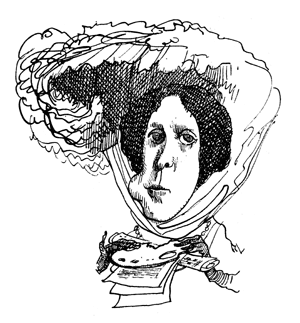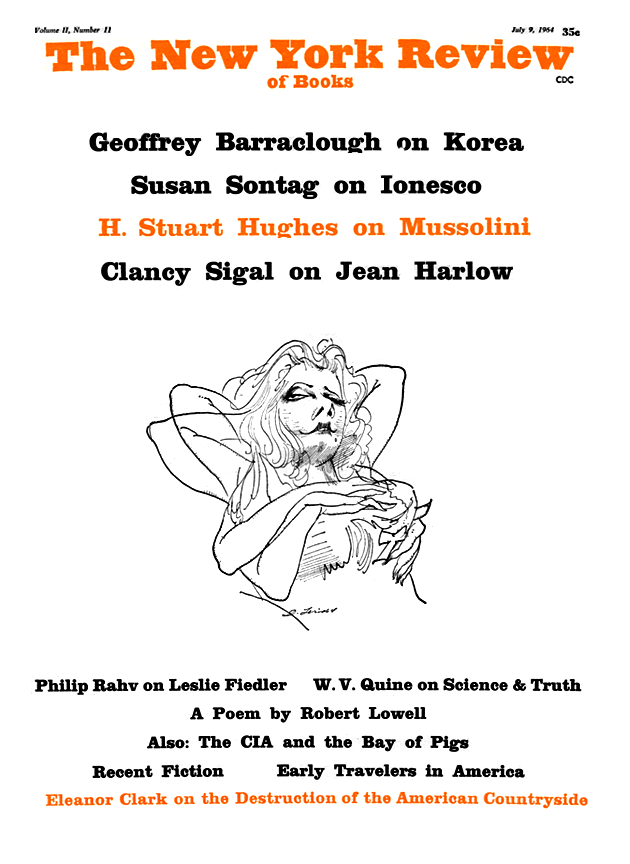A great hostess is at the mercy of her guests: they analyze and dissect her. If her guests are artists she may be pilloried in paint or print, skewered for all time. If she publishes her memoirs, they are likely to be vapid, fluttering, or egotistical and confirm all that her enemies have said. To this Lady Ottoline Morrell is no exception. When she wants to say something important she begins to stammer or drone. Insignificant sentences succeed each other, and one is irritated by the self-pity and incompetence. But on another level she writes remarkably well and you catch something of the spirit that made her circle regard her with hostility and then again with affection, always as something of an enigma.
She describes her childhood, for instance, with detached amusement. The fifth Duke of Portland, her father’s cousin, was in the great tradition of aristocratic eccentrics. When he traveled by train he had his own coach hoisted onto a goods truck where it remained with drawn blinds throughout the journey. A procession of chickens turned on the spit in the Welbeck kitchens so that whenever he should call for one it would be perfectly roasted. His sole joy in life was tunneling in and around the house. For his servants he built a roller skating rink and “if he ever came upon a housemaid sweeping, he would send out the frightened girl to skate whether she wanted to or not.” When Lady Ottoline’s brother inherited the title at the age of twenty-one, this was the house in which she was immured, a shy, enormous girl with darkred hair, knowing that she was alien to the excrutiatingly Philistine and class-circumscribed society in which her brother moved, knowing that she was bored and yearning—but for what? Bible classes with the Welbeck servants, travel with a companion, and an encounter with Axel Munthe left her without an answer. She found one only when she married Philip Morrell, a young radical who was to sit in the House of Commons and make a lonely stand for his friends who were conscientious objectors in the war of 1914. She had found someone who no longer thwarted but encouraged her dislike of the conventions, and she found the key to unlock the entrance to the world of artists and writers such as Augustus John and Henry Lamb, Old Bloomsbury and D. H. Lawrence.
Her descriptions of her manoeuvers in this world are almost always interesting when she is content simply to describe how people looked and what they said. They are marred whenever she adds what she felt or thought. She could neither observe like an artist nor define like an intellectual. She did not know how she related to her friends. She wanted to spread light and affection, to unite people in bonds of love to her and to each other and to brood over their communings. In her memoirs she sees herself as a diffident and respectful votive at the shrine of intellect and art.
This was not how her friends saw her. Yet it is by no means clear how they did see her. The paradox surrounding Lady Ottoline was that they saw her with the utmost clarity as an inquisitive and tiresome monster and with serene sincerity as a valued friend. The most famous portrait of her was painted by Lawrence as Hermione in Women in Love: “you are the real devil who won’t let life exist.” And yet Lawrence, years after, continued to praise her in letters to friends and wrote to her:
But don’t say you feel you’re not important in life. You’ve been an important influence in lots of lives as you have in mine; through being fundamentally generous and through being Ottoline. After all, there’s only one Ottoline. And she has moved one’s imagination.
Her relations with Bloomsbury are equally difficult to fathom. She came into their lives around 1908 when she met Vanessa and Clive Bell in John’s studio. They had been brought there by William Rothenstein, who in Vanessa’s words “seemed to crawl at her feet like some dark dwarf.” It was as a visual image that she impressed them first, and they continued to see her more as a portent and a curio than as a human being. Lytton Strachey became thoroughly unbalanced, dramatized his relationship with her as that of Gibbon and Lady Sheffield and collapsed into open snobbery. His infatuation lasted only for a couple of years but Bloomsbury as a whole became wary of her. They particularly resented her pretense that her house was a palace of truth where everything could be freely discussed: they used to say that when Ottoline found herself left behind in an argument owing to her ignorance she would break up the conversation by putting on grand airs. They were fond of applying Pope to her:
Advertisement
Superiors? death: and equals? What a curse! But an inferior not dependent? Worse!
In their letters Strachey and Virginia Woolf created a comical ogress, and in his memoirs David Garnett attacked her for meanness. But the comedy which they made out of her (which was the obverse of Lawrence’s serious indictment) has to be set against the stream of letters, meetings, and friendly relations that continued to exist between her and Bloomsbury until her death.
The truth is that she existed too much in her own right for anyone quite to believe that he had the measure of her. She did not tacitly insult her intellectual friends and artists, like a society hostess, by sailing into their world and ostentatiously sailing out again into the worlds of politics or rank. She did not modify her behavior or her views to suit the beau monde. But she had friends in it or around it as dear to her as those she made outside it. She was the friend of Raymond Asquith, Edward Horner and that circle of brilliant young men who were nearly all to be destroyed in the war; however much she was attracted by the world of imagination she could not enter it except on her own terms. These memoirs hardly give a hint of her strength of will, her imperious ability to get her own way, the unconscious ruthlessness that so often characterizes aristocratic behavior. Mr. Gathorne Hardy, the editor of her memoirs, tells elsewhere the story of Lady Ottoline and himself calling at Monet’s house in France when the painter was in old age and she unknown to him, and of her irritation at being foiled at every attempt to gain entry by an imperturbable gardien. This was not mere lion-hunting, he protests: it was simply that she desired above all to lay her offering at the painter’s feet. It may be so: but that is not how the lion sees it.
Had she not been so stubborn and fearless she could never have thrown off her family yoke or have supported her husband and friends when they were reviled during the war. Her hats might be vast, she might be draped in silks or appear like a galleon with yards of muslin fluttering in the wind, but nobody ever supposed she was affected. Her coo or her drawl were her own. This independence shines through her writing. If she writes of James or Conrad or Bertrand Russell she writes as a concerned but detached observer. Her observation was not especially perceptive or acute, but it was usually just and owed nothing to others. She knew what was up when James begged her not to try to meet Conrad (“But dear lady…but dear lady…he has lived his life at sea…he is interesting but he would not understand you…No, dear lady, he has lived a rough life and is not used to talk to….”); and her description of Conrad is a model of observing without affectation. She generously acknowledged the qualities that others had inherited from their upbringing, but she was no less insistent that she had gained something from her own breeding. As so often in English relationships the shadow of class falls across friendship.
The American edition of this book omits Mr. Gatherne-Hardy’s Introduction, which in some ways is a pity because it includes many stories about Lady Ottoline: but the reader is also spared a great deal of moist light.
This Issue
July 9, 1964



